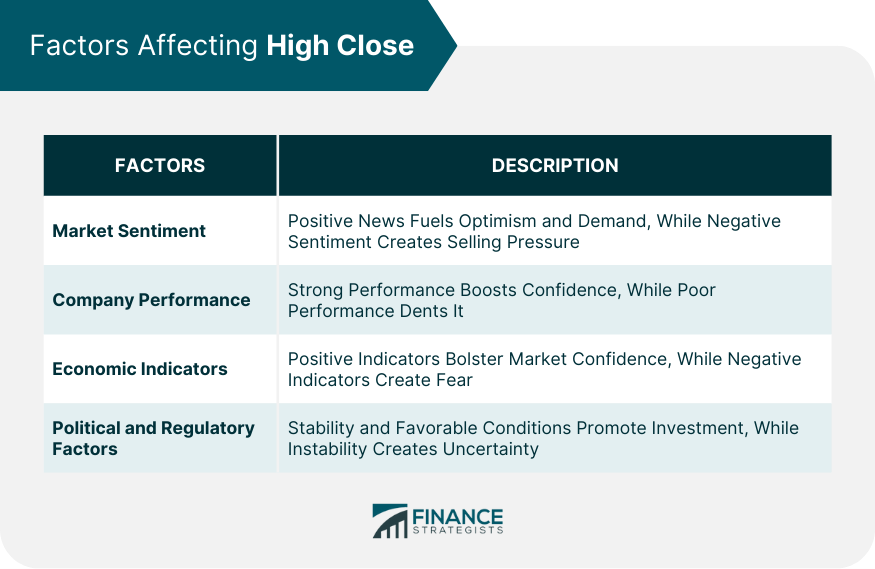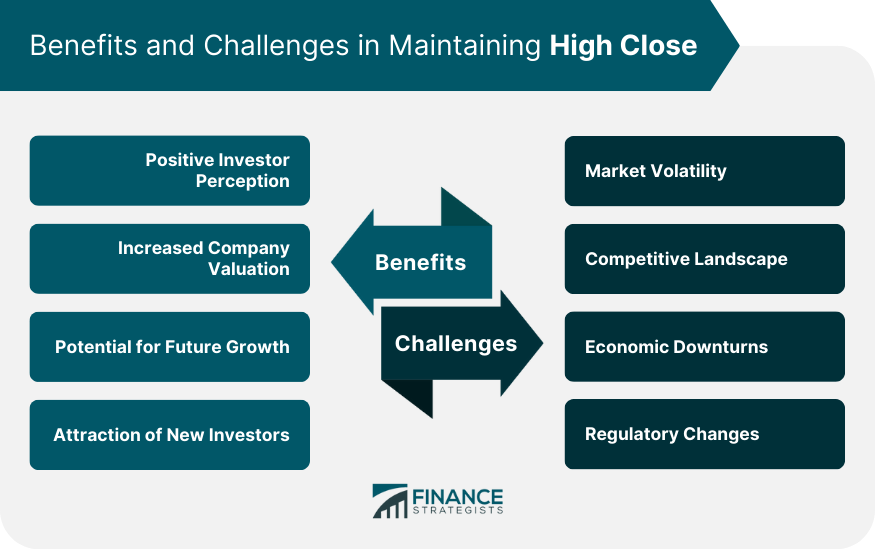A high close refers to a situation when the closing price of a security, such as a stock or bond, ends the trading day at or near its highest price of that day. It's a common term in the investment world, reflecting a security's end-of-day valuation and often signaling a robust demand or positive sentiment towards the security. The closing price is a crucial metric in the financial world, often used in calculating other technical indicators, assessing performance, and creating financial models. A high close implies that the trading session concluded on a bullish note, with buyers willing to pay a premium even at the end of the day's trading. A stock that consistently exhibits high closes can be seen as a positive signal, potentially indicating upward momentum, strong investor sentiment, and a robust financial performance by the underlying company. A high close can influence investment decisions as it often underpins investor confidence in the security. Positive news about the company, industry trends, or the broader economy can fuel optimism among traders and investors, driving up demand and pushing the closing price towards its daily high. On the other hand, negative sentiment, spurred by unfavorable news or events, can cause selling pressure, which may prevent a high close. The sentiment is often driven by numerous factors, including economic indicators, corporate earnings, geopolitical events, and market speculation. If a company consistently reports strong earnings, boasts a robust financial position, or announces positive future growth plans, it often leads to increased investor confidence. This can result in greater buying activity, potentially leading to a high close. Conversely, poor financial performance, disappointing earnings results, or bleak future prospects can dent investor confidence, causing selling pressure that could impede a high close. Economic indicators such as interest rates, inflation figures, employment data, and GDP growth rates significantly influence market sentiment and, consequently, the high close. Positive economic indicators can bolster market confidence, leading to increased buying activity and the possibility of a high close. In contrast, negative economic indicators can provoke fear and uncertainty in the market, often leading to selling pressure and making a high close less likely. Political stability and favorable regulatory conditions can promote a positive investment climate, thereby influencing a high close. Policies that are supportive of business growth, stable political conditions, and positive diplomatic relations can boost investor confidence and stimulate buying activity. Conversely, political instability, adverse regulatory changes, and geopolitical tensions can create uncertainty, often leading to increased selling pressure that can prevent a high close. It signals strong demand for the security, implying investor confidence in the company's prospects. This positive perception can fuel further buying interest, potentially leading to price appreciation in subsequent trading sessions. The closing price is a key input in several valuation metrics, such as the price-to-earnings (P/E) ratio, used by investors to assess a company's worth. Higher closing prices can therefore increase these ratios, enhancing the company's overall valuation. A persistent trend of high closes suggests that investors are bullish about the company's future prospects, which could translate into future price appreciation and growth. It can indicate a strong performance and bright prospects, luring new investors who hope to share in the company's success. This can lead to increased demand for the company's shares, potentially driving the price even higher. Fluctuations in the market can lead to dramatic swings in a security's price, which can prevent it from closing near its daily high. High volatility often stems from economic uncertainties, corporate earnings shocks, geopolitical events, and other sudden market-moving events. If competitors are performing better or if the industry is experiencing a downturn, it may be difficult for a company to maintain investor confidence and achieve high closes. Economic downturns often lead to decreased investor confidence, which can prevent high closes. During such periods, investors may sell off their holdings due to fears of potential losses, leading to downward pressure on stock prices. Unfavorable regulatory changes can also pose challenges to maintaining high closes. Regulations that adversely affect a company's operations or profitability can lead to negative sentiment among investors, potentially leading to selling pressure and lower closing prices. This includes making strategic decisions to improve profitability, manage debts effectively, and ensure robust cash flow. Companies with strong financial management often attract investor confidence, which can lead to high closes. This includes transparency in operations, adherence to regulatory norms, and safeguarding shareholder interests. Companies with good corporate governance practices often enjoy higher investor confidence, contributing to upward price movement and potentially leading to a high close. Efficient operations and effective cost management can improve a company's bottom line, leading to increased investor confidence and a potential high close. Companies can achieve this by streamlining operations, adopting new technologies, outsourcing non-core activities, and implementing cost-saving measures. Maintaining strong investor relations and effective communication can play a vital role in achieving a high close. Regular and transparent communication about the company's performance, future plans, and market position can bolster investor confidence. This can lead to increased buying activity, contributing to a high close. A high close refers to a desirable financial outcome in which the closing price of a security or market is significantly higher than its opening price. Several factors can influence a high close, including market sentiment, company performance, economic indicators, and political/regulatory factors. Achieving a high close offers various benefits, such as positive investor perception, increased company valuation, potential for future growth, and attracting new investors. However, maintaining a high close comes with its own set of challenges, including market volatility, a competitive landscape, economic downturns, and regulatory changes. To navigate these challenges, companies can employ strategies such as effective financial planning, strong corporate governance, efficient operations and cost management, and effective investor relations and communication.What Is a High Close?
Factors Affecting High Close
Market Sentiment
Company Performance
Economic Indicators
Political and Regulatory Factors

Benefits of High Close
Positive Investor Perception
Increased Company Valuation
Potential for Future Growth
Attraction of New Investors
Challenges in Maintaining High Close
Market Volatility
Competitive Landscape
Economic Downturns
Regulatory Changes

Strategies to Achieve High Close
Effective Financial Planning
Strong Corporate Governance
Efficient Operations and Cost Management
Investor Relations and Communication
Conclusion
High Close FAQs
A high close refers to the situation when a security concludes the trading day at or near its highest price for that specific day. It is a significant aspect of finance as it signifies positive market sentiment, upward momentum, and strong financial performance. Investors often interpret a high close as a favorable signal, indicating potential profitability and growth opportunities.
A high close is often seen as a positive signal indicating upward momentum, strong investor sentiment, and robust financial performance by the company. When a security or market ends the trading day with a high close, it suggests that demand for the asset was strong, resulting in an increase in its price. This upward momentum indicates positive market sentiment and can attract further investor interest.
Several factors can influence a high close. Market sentiment plays a crucial role, as positive investor sentiment can drive prices higher. Additionally, company performance, including factors like revenue growth, earnings reports, and overall financial health, can impact the closing price. Economic indicators, such as interest rates, inflation, and GDP growth, also contribute to a high close. Furthermore, political and regulatory factors, such as changes in government policies or industry regulations, can affect market conditions and ultimately influence the closing price.
Achieving a high close offers numerous benefits for companies. It can enhance investor perception, creating a positive image and attracting more investment. A high close can also increase the company's valuation, as a strong closing price reflects higher market demand for its securities. Moreover, it indicates potential for future growth and expansion, as investors see the company as a promising investment opportunity.
Companies can use strategies such as effective financial planning, strong corporate governance, efficient operations and cost management, and effective investor relations and communication to achieve a high close.
True Tamplin is a published author, public speaker, CEO of UpDigital, and founder of Finance Strategists.
True is a Certified Educator in Personal Finance (CEPF®), author of The Handy Financial Ratios Guide, a member of the Society for Advancing Business Editing and Writing, contributes to his financial education site, Finance Strategists, and has spoken to various financial communities such as the CFA Institute, as well as university students like his Alma mater, Biola University, where he received a bachelor of science in business and data analytics.
To learn more about True, visit his personal website or view his author profiles on Amazon, Nasdaq and Forbes.















